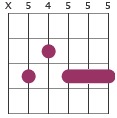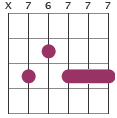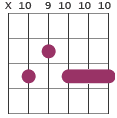9th chords
The 9th chord is frequently used in styles such as funk and jazz. The chord is constructed by adding the ninth note in the scale to a dominant 7th chord. The C9 for example, includes the following notes: C, E, G, Bb and D.
9
Alt. shape
Comment
The diagrams show the 9th chords in movable versions. Adapting to these versions makes the chord really simple to memorize.
To play the chord you have to lay your ring finger over the three highest strings (see picture to the right). The thumb could be on top of the neck, to accomplish the right angle of the hand and avoid muting note of the fourth string. It's also possible to skip the high E-string (i.e. the 1st string), and in that case you can instead use all four fingers. If you leave out the high E-string, you will not play the fifth, but it's alright to omit that note in a 9th chord.
Funk or jazz?
To generalize, the movable shape in the left diagram is especially suited for funk whereas the movable shape in the right diagram is often used in jazz.
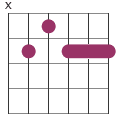
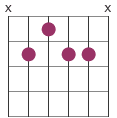
From a theoretical standpoint, what differs is that the fifth interval is omitted in the second version.
9th chords with flats and sharps
Additional chords in this category:
C sharp / D flat 9th: X43444
D sharp / E flat 9th: X65666
F sharp / G flat 9th: X 9 10 9 9 9
G sharp / A flat 9th: X 11 12 11 11 11
A sharp / B flat 9th: X10111
Chord formula
The ninth is built with the formula 1-3-5-b7-9 (root, major 3rd, perfect 5th, minor 7th and major 9th).
Chord construction
C9 x - C - E - Bb - D - GD9 x - D - F# - C - E - A
E9 x - E - G# - D - F# - B
F9 x - F - A - Eb - G - C
G9 x - G - B - F - A - D
A9 x - A - C# - G - B - #E
B9 x - B - D# - A - C# - F#
Guitar versions of the chord
Notes in chord
C9 C - E - G - Bb - DD9 D - F# - A - C - E
E9 E - G# - B - D - F#
F9 F - A - C - Eb - G
G9 G - B - D - F - A
A9 A - C# - E - G - B
B9 B - D# - F# - A - C#
The intervals are 1 – 3 – 5 – b7 – 9
Chord progressions
If you know how to play a 12 bar blues chord progression you can mix it up by replacing the IV7 and V7 with IV9 and V9. A 12 Bar Blues progression could look something like:
A7 – D9 – A7 – E9 – D9 – A7
9th chord in open position
The 9th chords are most often played in closed positions as seen on diagrams above, but here are some suggestions for open 9th chords:
C9: X32330
D9: X54530
D9/F#: 200210
D#9 / Eb9: XX1021
E9: 022102 / 020132
G9: 320201 / 3X0201
A9: X02423
A#9 / Bb9: X10111
9th chord voicings without the root
Another way to play these chords is to remove the tone on the 5th string. This turns the chord into a voicing without the root note and, for example, C9 will be played XX2333 and F9 will be played as XX7888.
In blues, a popular rootless inversion is by using the same shape as in the m7b5 chord, for example, A9/C# as X4545X.
9th chords with bass note on 6th string
To become more flexible, you should learn a shape with its base tone on another strings. These shapes are using the 6th string for the bass and root note. None of the shapes are all that pleasing: the first include a stretch and the second creates a somewhat bassy sound.
G9: 3X320X / 3230XX
Ab9: 4X431X / 4343XX
A9: 5X5412X / 5454XX
Bb9: 6X653X / 6565XX
B9: 7X764X / 7676XX
G9 can also be played without the 3rd as 3X323X.
9th chords with bass note on 4th string
Here is an alternative that use the 4th string for the bass and has the root note on the 1st string.
G9: XX3203 / XX5465
Ab9: XX4314
A9: XX5425
Bb9: XX6536
B9: XX7647
9th chord inversions
A 9th chord is possible to play in numerous configurations including four inversions (it's also common to combine inversions with omitting notes for this chord type).
C9 can be used as an example:
- C - E - G - Bb - D (root position)
- E - G - Bb - C - D (1st inversion)
- G - Bb - C - D - E (2nd inversion)
- Bb - C - D - E - G (3rd inversion)
- D - E - G - Bb - C (4th inversion)
To indicate that a chord is played inverted it is written as slash sign before the bass note. For example, the first inversion of the C9 chord is written C9/E. Some examples follow below in short notation:
C9/E: 032333
C9/G: 310010
C9/Bb: X10010
D9/E: 000323
D9/F#: 200320
D9/C: X34230
E9/A: X02132
E9/B: X24230
F9/C: X33045
G9/E: 000001
G9/F: 100001
A9/C#: X42005
A9/E: 002423
A9/G: 302420
B9/C#: X4120X
B9/E: 021222
B9/F#: 211300
For more chord diagrams, see The Chord Reference ebook.
9th sus chords
It's also possible to play ninth suspended chords. A movable shape similar to that presented above can be used, here are some examples in notated form:
B9sus: X22222
C9sus: X33333
D9sus: X55555
E9sus: X77777
F9sus: X88888
Notice that 9sus is identical with one version of the 11th chord.
9th chord alterations
Alterations means that a note in the chord is altered, for example, a flattened fifth. See the presentation of alterd chords. Here are some examples using C as root tone (the shapes are movable). To being able to play C9b5 according to the fingering below, you must bar four strings.
C9+5: X32334
C9b5: X32332
We can compare these alterations with the standard dominant ninth:
Chord construction
C9 x - C - E - Bb - D - GC9+5 x - C - E - Bb - D - G#
C9b5 x - C - E - Bb - D - Gb
Guitar versions of the chord
Notes in chord
C9 C - E - G - Bb - DC9+5 C - E - G# - Bb - D
C9b5 C - E - Gb - Bb - D
Theoretical order of notes
In C9+5 the fifth is raised and in C9b5 the fifth is flattened.
See also 9th suspended.

